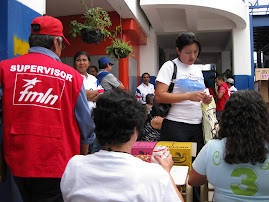We had the opportunity this past weekend to appreciate the beauty of El Salvador while learning more about the atrocities of the war. Sixteen of us boarded a hired bus at 6:00 a.m. on Saturday and set out for Morazan, El Salvador’s most northeastern department. This mountainous part of the country was the site of the El Mozote massacre in 1981 in which all but one survivor were brutally slaughtered, and a museum about the civil war of 1980-1992 is housed in Perquín.
This was my second trip to these sites, but I am still angered when I see photographs of U.S. military alongside the Salvadoran military and remember the huge amount of military aid our government gave to the Salvadoran government during the war.
In El Mazote we were met by Gumercindo Claros, a member of the tourist committee which is dedicated to keep the memory of the tragedy alive and a descendent of the indigenous people of El Salvador. He related the following story to us.
In the early hours of the morning on the 11th of December, 1981, the people of El Mazote, a village in the northern part of Morazan, were brought together in the plaza and separated into groups. Men and adolescent boys were in one group and women and younger children in the other. The executions began with the men and boys. Then they separated the youngest of the women from the rest and raped, tortured and executed them. That night the children and babies (the youngest was 3 days old) that were in the village chapel were killed by the soldiers and their bodies thrown into the convent next to the chapel. The convent was then set on fire. Later a second battalion arrived and killed all the animals and burned the crops. This was the “scorched earth” practice used by the U.S. in Vietnam.
The commander in charge of the battalion which committed these atrocities was Lieutenant Colonel Domingo Monterrosa, who received his training at the School of the Americas (now known as the Western Hemisphere Institute for Security Concerns) located at Fort Benning, Georgia. Monterrosa must have been an extremely sick man to order the torture and killing of so many. The story is that Monterrosa demonstrated and then ordered the soldiers to throw the babies into the air and then pierce the bodies with their swords.
After this tragedy, the United States sent an investigator to check out the veracity of the story. And who accompanied this investigator while he was in El Salvador? Monterrosa! This combined with the Reagan’s intentional cover-up led the U.S. to do nothing about the incident at that time.
Unfortunately, the event at El Mozote was not an isolated event. Many massacres of rural families took place in other departments such as Chalatenango, San Vicente, and Cabañas between 1980 and 1984, the year Monterrosa was killed.
After the Peace Accords were signed, the legal office of the Archbishop asked a team of Argentinean forensic biologists to investigate. This team, assisted by experts from the U.S., concluded that it was a massive execution done all at once, and that the victims did not die in a cross-fire between the two armies. To date, a list of more than 800 people who could be identified, including 420 children, has been compiled. Those names are engraved on plaques on the side of the chapel.
This trip did include some diversions such as swimming in the Rio Sapo, hiking up a mountainside near Perquin, and taking photos of the mountainous terrain. The Rio Sapo, fed by mountain streams, has many boulders and smaller rocks which have formed pools ideal for swimming. Because it is so high, the river has not been polluted by animals and industry.
Subscribe to:
Post Comments (Atom)


























1 comment:
Thanks very much for your writings! I plan to share them with the seminary students of Chicago.
Le Anne Clausen,
convicted and sentenced to 30 days for nonviolent civil disobedience to shut down the SOA
Post a Comment